

The following nunneries in Perugia have separate pages in this website:
-
✴San Benedetto dei Condotti, which belonged to the Sylvestrine nuns from Sant’ Erminio (see below) from 1641 until 1820;
-
✴San Bevignate, which housed a nunnery under the auspices of the Knights of St John of Jerusalem from 1324 until ca. 1507;
-
✴the nunneries of the Blessed Colomba of Rieti in Corso Cavour and Corso Garibaldi;
-
✴Sant' Erminio, which was a Sylvestrine nunnery from ca. 1293 until 1641, and which has belonged to the nuns of Santa Maria di Monteluce (below) since 1927;
Monastero delle Bartolelle (1604)
This nunnery was established under the terms of the will of Giovanni Antonio Bartolelli and under the auspices of Bishop Napoleone Comitoli. It was in Via Torcoletti, which takes its name from the small cakes baked by the nuns. It was suppressed in 1798, when the nuns moved to Santa Maria di Monteluce. They managed to return a year later, but the nunnery was definitively suppressed in 1810. It was demolished in ca. 1870 to make way for a new women’s prison.
Santa Chiara (1552)
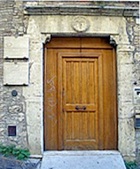
This had probably been the site of the church of Santa Mustiola, which had belonged to the Confraternita di Sant' Andrea della Giustizia before its demolition in 1537. The confraternity, which had moved to the Oratorio dei SS Andrea e Bernardino at that time, administered the temporal affairs of the nuns until 1566. The Jesuits of the Chiesa del Gesù were responsible for the spiritual direction of the nuns from 1556.
This community was suppressed in 1863. The complex was adapted for industrial use in the period 1912-39, and then for residential use. Part of it housed the State Archives from 1941.
This portal from the 16th century church survives in Via Tornetta. The relief on the lintel depicts a Franciscan cord around a cross.
The complex now houses the Associazione Porta Santa Susanna.
Santa Lucia (1472)

The church was restored in 1614 [and received the relics of St Justina in 1696.]
The church was restored again in 1815. In 1817, the few remaining nuns from the nearby Franciscan nunnery of Sant’ Antonio da Padova were moved here, and the nuns opened a school for poor young girls. The school and the buildings passed to the Conservatorio Antinori, an organisation devoted to the education of poor young girls, in 1851. It retains this name but is an elementary school.
Art from the Church
Pietà and symbols of the Passion (15th century)
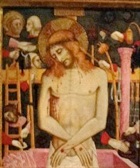
Mystic Marriage of St Catherine (1608)
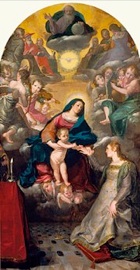
St Augustine in Meditation (17th century)
This altarpiece, which is attributed to Giovanni Francesco Bassotti, was documented on the high altar on a number of occasions between 1683 and 1822. It was subsequently moved to Sant’ Agostino (presumably in 1851, when the complex of Santa Lucia passed to the the Conservatorio Antinori). [It is still there ?]
The altarpiece depicts St Augustine kneeling in a landscape and looking up at two visions: the Crucifixion, on the left; and the Immaculate Virgin, on the right. Three putti around him play with his book, his staff and his mitre.
Madonna and Child (17th century)
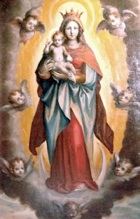
Santa Margherita (13th century)

This palace in Parco Santa Margherita
stands on the site of the demolished nunnery
The hermitage of “Santa Margherita in Massa Saliarica”, which a group of Camaldolesians established outside Perugia, was documented in 1037, when the Emperor Conrad II mentioned it as a hermitage dependent on Sant’ Apollinare in Classe (near Ravenna). It was mentioned again in this capacity in 1229 in a bull of Pope Gregory IX.
In 1248, a lady called Benvenuta di Cilino di Assisi made bequests to a number of nunneries in Perugia:
-
✴Santa Caterina (later Santa Caterina Vecchia);
-
✴Sant’ Angelo di Arenaria (or del Renaio), near Cenerente (some 4 km outside Porta Sant' Angelo), which later transferred to San Francesco delle Donne;
-
✴Santa Maria di Monteluce; and
-
✴Santa Margherita.
This last nunnery, which seems to have belonged to a Benedictine community that had acquired the site of the old hermitage, was documented again in 1296, when the abbess requested a license from the bishop.
In 1399, Pope Boniface IX ordered that the community should absorb that of San Bernardo (see Walk VI). In 1428, Pope Martin V ordered that they should also absorb the merged communities of Santa Maria delle Vergini and Santo Spirito.
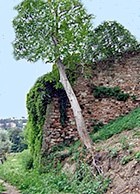
Art from the Nunnery
Santa Margherita Altarpiece (1547-9)
This altarpiece from Santa Margherita in the deposit of the Galleria Nazionale was the subject of three payments made in 1547-8 to Lattanzio Pagani and the otherwise unknown Organtino di Mariano. The date 1549 appears in the inscription:
-
✴The main panel, which depicts the Madonna and Child enthroned with SS Benedict and Bernard, is not thought to be the work of Lattanzio Pagani, and is thus presumably by Organtino di Mariano.
-
✴The predella, which depicts the martyrdom of St Margaret and figures of SS Christopher and Catherine of Alexandria, is usually attributed solely to Lattanzio Pagani.
Santa Maria della Colombata (ca. 1300)
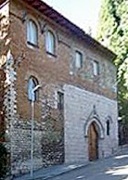
This church (also known as Santa Maria di Colle Amato), which was built on the site of an ancient hermitage, became a Benedictine nunnery in 1297.
Bishop Giovanni Andrea Baglioni suppressed the nunnery in 1437 because of the bad behaviour of the nuns, and sold its goods to help with the financing of the new Duomo. Pope Eugene IV subsequently allowed the church to be partially demolished to provide building materials for the project.
The complex was then put to a number of uses:
-
✴It belonged to the Gesuati (the Order of Hermits of Saint Jerome, which Pope Urban V approved in 1367 and which Pope Clement IX suppressed in 1668) in 1454-99.
-
✴A community of Poor Clares lived here in 1499-1528.
-
✴It is documented as an isolation hospital in 1528.
A group of nuns from the Monastero della Beata Colomba moved here in 1528 but they were sent back to their mother house in 1575, probably because of their bad behaviour. The complex then passed into secular use.
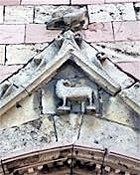
S. Maria Maddalena delle Convertite (1562)
The Confraternita della SS Annunziata established this nunnery for reformed prostitutes in Via del Parione. It was extended in 1603 but suppressed during the French occupation, when it was used as a brothel. When papal authority was (temporarily) restored to Perugia in the early 18th century, the complex became a “Casa di Correzione” for women. It was demolished in ca. 1870 to make way for a new women’s prison.
Santa Maria delle Orfane (1616)
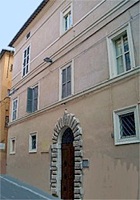
The orphanage for girls moved to Santa Maria degli Angeli in the early 19th century. This complex then housed the boys from Santa Maria degli Angeli and those from SS Annunziata.
San Paolo (1541)
The original church and nunnery here was dedicated to St Elisabeth of Hungary. The complex passed to a community of female Franciscan tertiaries in 1541, when their Monastero di San Paolo di Colle Landone was demolished to make way for Rocca Paolina. The nuns rebuilt and re-dedicated the nunnery. They were expelled in 186o and the complex was subsequently adapted for secular use.
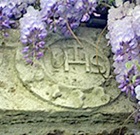
San Paolo di Favarone (13th century)
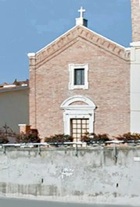
From 1790, the complex was used as a summer school attached to the seminary. It now privately owned.
San Sperandio (1262)
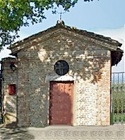
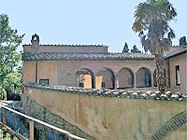
Ex-church (garage) next to Remains from the cloister incorporated
number 3 Strada Sperandio into the student residence at
number 5 Strada Sperandio
The Blessed Santuccia Carabotti established the nunnery here in 1262 on land given to her by a woman who had established a hermitage here. This seems to have been the first of the nunneries that Santuccia founded outside Gubbio. It is possible that there were originally two separate communities on the site (San Sperandio and Santa Maria Maddalena Bulgazzano) that were later united into a single community.
The 1279 statutes of Perugia mention San Sperandio. In 1305, after the death of Santuccia, the sisters of San Sperandio swore obedience to the new abbess of their mother house, Santa Maria in Giulia, Rome. This may be the date at which San Sperandio and Santa Maria Maddalena Bulgazzano became a singe community.
[There seems to have been an associated monastery nearby.]
Pope Paul III placed the nuns under the guidance of the monks of San Pietro in 1542, and this arrangement remained in place until 1702, when they returned to episcopal control.
The nunnery was suppressed in 1799 and its goods were transferred to the Orfanatrofio della Divina Misericordia, an orphanage for boys that had been established at Santa Maria degli Angeli.
The complex at San Sperandio was largely demolished in 1805.
Return to Monuments of Perugia.
Return to: Walk II (Santa Chiara);
Walk III (Santa Maria della Colombata; San Paolo);
Walk IV (Santa Maria delle Orfane);
Walk V (Santa Lucia; San Sperandio);
Walk VI (Santa Margherita; San Paolo di Favarone);
Walk VII (Monastero delle Bartolelle; Santa Maria Maddalena delle Convertite).

